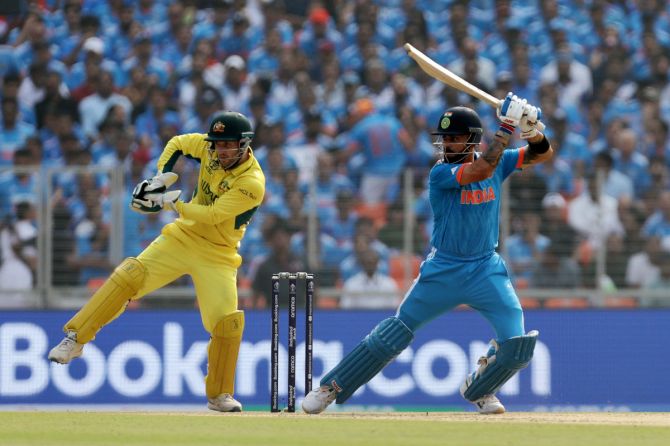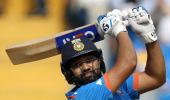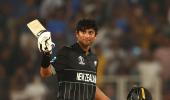It is a tribute to a system so robustly meritocratic that this team represents India's diversity better than any other institution: The Union Cabinet, our chief ministers, the civil services, the leadership of our armed forces and security agencies, the judiciary and more than all of these, our typical newsroom.
That is the biggest message from this breathless rise of Indian cricket, asserts Shekhar Gupta.

When India began its campaign in this World Cup, both its critics and fans had the same complaint: That it hadn't won any International Cricket Council trophy for a full decade, since that Champions Trophy in Birmingham in 2013.
It always made the knockouts but only to lose, once even to Pakistan (Champions Trophy again, at The Oval in 2017).
This meant something had to be fundamentally wrong with Indian cricket.
Fans are as fickle as critics are bloodthirsty. In these contrary emotions, both can miss the real story.
It is the revolution in Indian cricket. A revolution my generation could never dream of.
And a revolution built around not one or two star batsmen but the most effective pace attack in the world.
The rise of pace, the greater fitness and fielding standards, and the rising wealth of players are the three pillars on which this revolution is built.
Why, then, had India not won an ICC trophy for so long? Who was to blame -- the Board, the selectors, the players, or all of these? The usual suspect is the IPL.
It supposedly ruined the discipline, national commitment and talent of Indian cricketers.
Worse, it 'reduced' them to arrogant showmen greedy for money, privileging their auction prices above national glory.
There was, and is, however, another way of assessing the health of Indian cricket.
The decade-long ICC trophy drought apart, at the point you are reading this, this same Indian team holds the number one spot in ICC rankings in all three formats of the game.
That many are sceptical of these rankings does not change the fact that they exist and matter.
The fans will only be more disappointed if these rankings are lost.
Over the past two decades, we've progressively got used to ranking number one. Some data is worth checking out.
In Test cricket, the most challenging form of the game, India first reached the number one spot in 2009 -- 77 years after playing its first Test.
Since then, India has held the number one spot in Test rankings seven times, with periods at the top lasting 70 months, or almost six years.
Of these 70 months, 49 fall between January 2016 and January 2022.
Australia pushed India to number two from January 2022 to May 2023, then India climbed back up.
India is the only team in a long time to beat the Aussies in four consecutive series -- the last four. Two series each, home and away.
In One Day Internationals (ODIs), India became world number one for the first time in January 2013, nearly two years after winning the World Cup in Mumbai.
It has been ranked number one eight times since. That is an incredible sway over the most prolific form of the game.
For some months earlier this year, Pakistan and Australia grabbed the spot from us.
That was the period when the fan frustration peaked. We were back there as this World Cup began.
In T-20s, now commercially the fastest growing format, the Indian reign may not be as consistent. Yet, it's been at the top five times since 2011, and now for 21 consecutive months since February 2022.

It is true that a big tournament is decided on the performance on the day of the final match, when rankings do not matter.
Who would know that better than India, having won its first World Cup, Lords, 1983, entirely against the form book and the run of play.
There were no ICC rankings then, but nobody would doubt that Clive Lloyd's West Indies was the top team in the world by some distance.
Any Indian delusions were quickly dissolved as the West Indies came for a bilateral series immediately following that World Cup final and simply destroyed India in both Tests and ODIs.
World cricket's pecking order has changed greatly since then, and so dramatically that in this edition, for the first time, the West Indies failed even to qualify, while Afghanistan made waves, and The Netherlands made an appearance too, returning with one big upset (South Africa) to its name.
The other big shift is in what always was the greatest denominator of power in world cricket: Fast bowling.
It is here that India has made the biggest improvement.

The Pakistani pace has declined -- in fact, it has never reached its original lethality after the bottle top incidents and greater ICC scrutiny of ball-tapering, never mind the frequent celebrations, especially in the English media, over the rise of some new prodigy: From Mohammad Amir to Shaheen Shah Afridi.
The Australians are more than adequate in that department, while South Africa and England are reconstructing.
Both the talent and the depth in this department are key factors in reaching the top, and staying there so often and for so long.
This is an Indian success story, the Blue Revolution, of a rise over two decades, and no fleeting moment of glory, like 1983.
That is because the game in the country has seen systemic changes for the better.
The markets for cricket have all moved here along with the centre of power.
The biggest reason behind this success is the rise of a true meritocracy.
As Shah Rukh Khan's latest blockbuster, Jawan, showed, we all love to attack and curse that amorphously defined thing called the 'system' in our country.
What's the system in cricket?
A Jay Shah today, Anurag Thakur yesterday, Sharad Pawar, Jagmohan Dalmiya, N Srinivasan, Madhavrao Scindia, or I S Bindra, the day before yesterday, and Rajeev Shukla all the time, are easy targets.
They were not cricketers, so what business did they have running the game? It was easy to attack them.
Even the holiest of the holy, the Supreme Court of India, waded into that.
It is just that it took the BCCI from Anurag Thakur and finally handed it back to Jay Shah.
The mightiest in Indian bureaucracy joined hands with the Supreme Court and well-meaning virtue signallers to 'reform' Indian cricket and free it from the 'clutches' of politicians and businessmen.
That they failed so spectacularly is what saved Indian cricket.
It speaks of the strength of Indian cricket and the commitment of the much-maligned group running it that the game was protected through this upheaval.
It cost the Board some Rs 20 crore to Rs 30 crore (Rs 200 million to Rs 300 million), most of it in fees, as part of the court-mandated retired judge-bureaucrat re-employment plan and golden handshakes.
But the system of fair selections, investment and development of the game was protected.

The results, we can see. Indian cricket has among the fairest and most meritocratic selections for any field in our country.
Fairer than politics, the civil services, and, for heaven's sake, the judiciary.
It's been a long time since we saw a true selection controversy.
Whoever might run the Board, they know that if they mess up selections and the team performance declines, the market will punish them.
You may not fear the judges. But you fear the fan who is the consumer of the game and who speaks through the market.
You can google and check out the geographical, regional, religious and caste spread of this Indian squad.
You'd find nothing, no institution, which represents the diversity of India better than this.
And everybody is there on merit. Unlike South Africa, India never fell for some nonsensical proportional system or affirmative action in sport.
It is a tribute to a system so robustly meritocratic that this team represents India's diversity better than any other institution: The Union Cabinet, our chief ministers, the civil services, the leadership of our armed forces and security agencies, the judiciary and more than all of these, our typical newsroom.
That is the biggest message from this breathless rise of Indian cricket.
That merit will find its way to the top, provided you create a true meritocracy.
It follows that only the market can ensure that, as cricket shows, not any government fiat, judicial intervention or affirmative action.
By special arrangement with The Print
Feature Presentation: Aslam Hunani/Rediff.com












 © 2025
© 2025